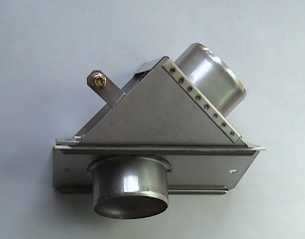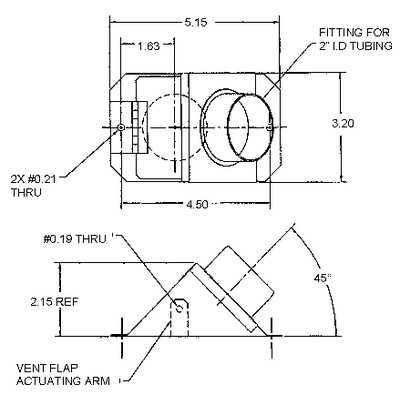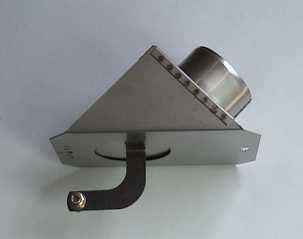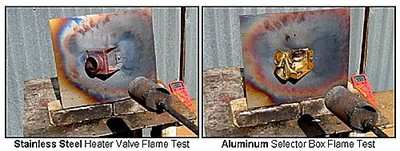And It Supposedly Stays Cool Up To 1,800 (F)!
By ANN Contributor John Schmidt
 The other night, during an EAA
chapter meeting, someone starts the DVD player and says "Watch
this." It's a demo DVD from a company called EPM-Avcorp, based
in Utah. It shows the quest of a homebuilder who, concerned about
the possibility of fire breeching his RV6A firewall, decided to
roll up his sleeves and design a better mousetrap.
The other night, during an EAA
chapter meeting, someone starts the DVD player and says "Watch
this." It's a demo DVD from a company called EPM-Avcorp, based
in Utah. It shows the quest of a homebuilder who, concerned about
the possibility of fire breeching his RV6A firewall, decided to
roll up his sleeves and design a better mousetrap.
The result was the all-stainless-steel heater valve, one that
won't melt in the face of flames to 1,800 degrees F.
The DVD, about 10 minutes in length, shows this builder's efforts
to design a testing environment similar to those conditions
experienced in the grim case of an in-flight engine fire.

"Most pilots don't know the temperature of burning avgas," Paul
Bowmar, the man you reach when calling EPM-Avcorp, explains. "We
looked to build a better heater valve, one that would stand up to
an engine fire. I wanted to give the pilot a chance to turn off the
fuel, turn off the electrical, and get the aircraft safely on the
ground."
"We needed to develop a test. We found that avgas burns at roughly
1,600 degree F in static, and about 1,800 degrees F in a windblown
state, as found in a pressure cowl. We then needed a testing
environment, so we took some stainless steel and made a modified
firewall."
"Our flame source was nothing more than a weedburner that we named
'Puff,' as in Puff the Magic Dragon. It burns at a temperature
range between 1,800 and 2,000 degrees F, perfect for our testing.
We mounted 'Puff' 16 inches away from our mock firewall, mounted an
aluminum heater valve, lit it, and watched. The aluminum melted
away in 16 seconds."
And the firewall was breeched. In the DVD, one can see the aluminum
valve literally fall off the firewall, and flames come through the
hole.
Then the DVD shows the results from the same test, this time with
an EPM-Avcorp stainless steel heater valve. This time, the flames
shot at the heater valve for 10 minutes. The heater valve held on,
without letting the flames through the firewall. "It got scaly, but
it just didn't break down," says Bowmar.

Next, Bowmar and EPM-Avcorp set its sites on the wires and
connections going through firewall. Rubber grommets with stainless
shields and aluminum eyeball fittings didn't hold much promise or
resistance under Puff's flames (again, shown on the DVD), so other
materials were researched.
"We searched for 4 months for materials would work," said Bowmar.
"Finally, we found something called Biotherm 100. It's a 2000
degree sealant. It held up. We'd burn for 10 minutes at a time
without a sign of flame going through the firewall."
EPM-Avcorp is a small company, but they have sights set on larger
goals. "We'd like to get our product STC'd for all piston-powered,
single engine airplanes. Right now we're working with a FAA DER
(Designated Engineering Representative). We'll start on my Cessna
140, then go to my brother's Cessna 185. After that, we'll go after
( STC certification on) every Piper, Mooney, and Cessna we
can."
Bowman said the FAA requires, for fireproof certification, exposure
to 2,000 degrees, plus or minus 100 degrees, for 15 minutes. "We
believe our product will hold up to that standard; it already has,
in our testing."
"We'll do conformity tests, and set up a date to actually go in the
FAA labs with our product, to gain our first STC
certification."

"We don't expect to get our heater vents certified because the
heater valves are all different on all airplanes. We're going after
the market for the wires and controls going through the firewall.
We want a mechanic to suggest, at annual '…as long as we're
working on the firewall, let's replace these grommets with
fire-resistant ones.' Of course, on experimentals, you can use our
products right now. We're also looking at marketing for industrial
applications for this technology."
According to Bowmar, EPM-Avcorp has not contacted the big piston
single manufacturers - yet. "We're going to wait until we have our
STC's in hand before that," he says. Raytheon has a similar product
that they market for their Bonanzas, but, according to Bowmar, the
EPM-Avcorp product costs less, and is much lighter.

EMP-Avcorp is also developing other fire-proofing-related products
for aviation use, and says that they will post the availability of
those products on their website as available. "I don't want to
promise something before we have it on hand," Bowmar
explains.
The source of that DVD? It's not mentioned anywhere on the
EPM-Avcorp website. Bowmar states "I've been calling the presidents
of every currently-active EAA chapter (some 850-plus!), offering
them a DVD of our testing, for free. Every night I'm on the
phone."
(EAA member John Schmidt makes his home in Minneapolis,
MN)
 Airbus Racer Helicopter Demonstrator First Flight Part of Clean Sky 2 Initiative
Airbus Racer Helicopter Demonstrator First Flight Part of Clean Sky 2 Initiative Diamond's Electric DA40 Finds Fans at Dübendorf
Diamond's Electric DA40 Finds Fans at Dübendorf ANN's Daily Aero-Term (04.23.24): Line Up And Wait (LUAW)
ANN's Daily Aero-Term (04.23.24): Line Up And Wait (LUAW) NTSB Final Report: Extra Flugzeugbau GMBH EA300/L
NTSB Final Report: Extra Flugzeugbau GMBH EA300/L Classic Aero-TV: 'Never Give Up' - Advice From Two of FedEx's Female Captains
Classic Aero-TV: 'Never Give Up' - Advice From Two of FedEx's Female Captains







